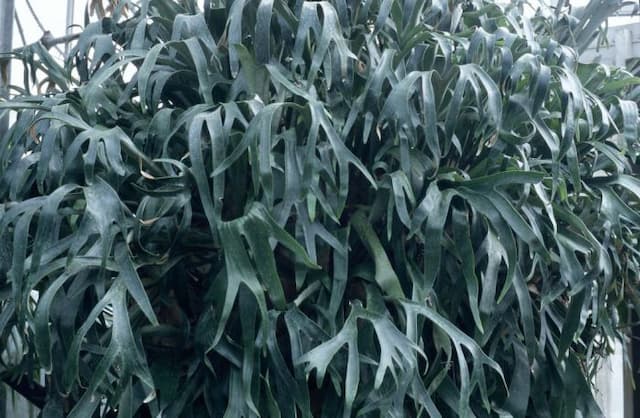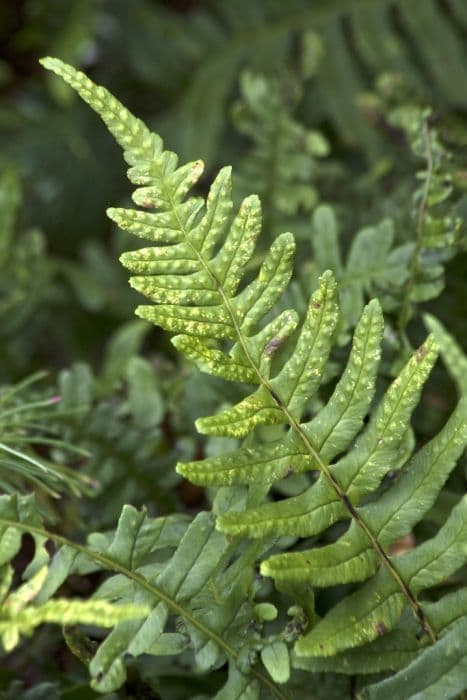Southern Polypody Polypodium cambricum 'Cambricum'

ABOUT
The common name for Polypodium cambricum 'Cambricum' is Southern Polypody. This plant is a type of fern with a unique and decorative appearance. The fronds are the most striking feature, being deeply divided with an overall lacy and delicate look. Each frond is elongated with a feathery texture, characterized by numerous small, leaf-like structures known as pinnae lined along their length. The overall shape of the fronds can be described as roughly triangular. The color of Southern Polypody is typically a lush, vibrant green, giving the plant a fresh and appealing look year-round. This shade of green can brighten up shaded garden areas or indoor spaces. Since the plant is an evergreen, it retains its color and foliage throughout the year, which adds to its aesthetic value. The surface of the fronds may have a somewhat leathery feel to it, contributing to their durability. On the underside of the fronds, one may notice small, round structures; these are the spore cases, which is how the plant reproduces. They add an additional element of texture and interest to the plant. Southern Polypody generally forms a dense clump, with the fronds arising from a central point. This gives the plant a full and robust look without being overly large or sprawling. The stems, also known as stipes, connecting the fronds to the rootstock, are relatively slender and may have a slightly scaly appearance. The root system is made up of creeping rhizomes that enables the plant to spread and colonize the surrounding area, albeit at a moderate pace. Overall, the Southern Polypody has a soft, elegant appearance that is especially well-suited to shaded gardens, woodland settings, or as a houseplant in areas with sufficient humidity and indirect light. Its fern-like characteristics provide texture and a deep, consistent greenery that complements a variety of other plants and garden designs.
About this plant
 Names
NamesFamily
Polypodiaceae.
Synonyms
Welsh Polypody, Cambrian Polypody.
Common names
Polypodium australe, Polypodium cambricum var. cambricum
 Toxicity
ToxicityTo humans
The Polypodium cambricum, commonly known as the Welsh polypody, is not known to be toxic to humans. There are no common reports of poisoning or adverse effects from ingesting this fern. However, as with many plants, it is generally advisable not to consume parts of plants that are not commonly known as food sources due to potential individual allergic reactions or unknown effects.
To pets
The Welsh polypody is not known to be toxic to pets either. It is generally considered a safe plant around animals, with no reports of toxicity in cats, dogs, or other household pets upon ingestion. Nonetheless, pets should be monitored if they ingest any plant material to watch for possible individual reactions or digestive issues.
 Characteristics
CharacteristicsLife cycle
Perennials
Foliage type
Evergreen
Color of leaves
Green
Height
1 foot (30 cm)
Spread
2 feet (60 cm)
Plant type
Fern
Hardiness zones
9
Native area
Europe
Benefits
 General Benefits
General Benefits- Aesthetic Appeal: Adds visual interest to gardens and natural landscapes with its distinctive fronds.
- Low Maintenance: Requires minimal care once established, making it suitable for both novice and experienced gardeners.
- Drought Tolerance: Can survive in dry conditions, reducing the need for frequent watering.
- Shade Tolerance: Thrives in shady areas where many other plants might struggle, providing texture and greenery in darker garden spots.
- Erosion Control: Its root system helps stabilize soil and prevent erosion on slopes or in areas with loose soil.
- Wildlife Habitat: Provides shelter and food for insects and other small wildlife, supporting local biodiversity.
- Evergreen Nature: Retains its foliage year-round, offering continuous greenery and structure in the garden.
- Garden Diversity: Contributes to plant variety in a garden setting, enhancing the overall diversity of plant life.
 Medical Properties
Medical PropertiesThis plant is not used for medical purposes.
 Air-purifying Qualities
Air-purifying QualitiesThis plant is not specifically known for air purifying qualities.
 Other Uses
Other Uses- Decoration: Polypodium cambricum, commonly known as the southern polypody, is often used in terrariums and bottle gardens due to its moderate size and tolerance of damp, shady conditions.
- Ecosystem Support: Southern polypody can be a food source for some species of butterflies and moths, whose larvae feed on the fern’s fronds.
- Cultural Symbolism: In certain cultures, southern polypody may be used symbolically in festivals or traditional art forms to represent nature and wilderness.
- Biological Indicator: This plant can be used as a bioindicator to signify the health of a habitat, particularly tightly closed forest ecosystems.
- Education: Southern polypody can be utilized in educational settings, such as schools and conservation programs, to teach about plant life cycles and fern reproduction.
- Photography: With their intricate frond patterns, southern polypody ferns can be a subject for nature photographers, providing aesthetic value and helping raise awareness about plant diversity.
- Crafts: The fronds of southern polypody can be pressed and used in crafts, such as creating bookmarks or inclusions in handmade paper.
- Shade Gardening: Gardeners may use southern polypody as a ground cover in shaded areas where other plants might struggle to grow.
- Water Features: Southern polypody can be planted around ponds or waterfalls in gardens, adding a lush, green backdrop and enhancing the natural appearance of water features.
- Floristry: Though not common, the fern can be used in floral arrangements, especially woodland-themed or greenery-focused designs, to add texture and a wild, natural look.
Interesting Facts
 Feng Shui
Feng ShuiThe Polypodium vulgare, commonly known as Common Polypody, is not used in Feng Shui practice.
 Zodiac Sign Compitability
Zodiac Sign CompitabilityThe Common Polypody is not used in astrology practice.
 Plant Symbolism
Plant Symbolism- Endurance: The Polypodium cambricum, commonly known as the Welsh polypody, is a hardy fern that can thrive in a variety of conditions, symbolizing one’s ability to endure and persevere through difficult situations.
- Longevity: Ferns are ancient plants that have existed for millions of years, hence the Welsh polypody represents the idea of long life and timelessness.
- Resilience: Able to grow on rocky substrates and withstand partial shade, the Welsh polypody signifies resilience and the capacity to recover from adversity.
- Solitude: Often found in solitary spots, the plant may symbolize the value of spending time alone for introspection and personal growth.
 Water
WaterThe Welsh Polypody should be watered weekly, allowing the top inch of soil to dry out between waterings. During the active growing season in spring and summer, increase watering slightly, but always be cautious not to overwater as this can cause root rot. It's best to use approximately 16 ounces of water per watering session for a medium-sized pot, but this can vary depending on the size of the plant and environmental conditions. Reduce watering in the fall and winter when the plant's growth slows down.
 Light
LightThe Welsh Polypody prefers bright, indirect light or partial shade, making it suitable for a north-facing window or a shaded spot in a brighter room. Direct sun can scorch its foliage, so avoid placing it in direct sunlight, especially during the peak intensity hours of the afternoon.
 Temperature
TemperatureThe Welsh Polypody thrives in a temperature range between 50°F and 75°F. It can survive minimum temperatures down to 30°F, but frost can damage the fronds. This fern prefers cooler conditions and should not be exposed to temperatures above 80°F as it can stress the plant.
 Pruning
PruningPruning the Welsh Polypody is primarily for removing any dead or yellowing fronds to maintain its appearance and health. This is best done in spring before new growth begins. Pruning is not frequently needed, as this fern does not grow rapidly. It is sufficient to check the plant seasonally and trim as necessary.
 Cleaning
CleaningAs needed
 Soil
SoilThe Welsh Polypody, prefers a soil mix that mimics its natural woodland floor habitat, which can be created with equal parts of peat moss, pine bark, and garden loam, ensuring good drainage and aeration. The ideal soil pH for Welsh Polypody ranges from 5.5 to 6.5, slightly acidic to neutral.
 Repotting
RepottingThe Welsh Polypody does not require frequent repotting and can be repotted every 2-3 years or when it has outgrown its current container.
 Humidity & Misting
Humidity & MistingWelsh Polypody thrives in moderate to high humidity levels, ideally between 60% and 80%, to replicate the moist environments of their woodland habitats.
 Suitable locations
Suitable locationsIndoor
Place in bright, indirect light; mist regularly.
Outdoor
Plant in shaded area with well-draining soil.
Hardiness zone
5-9 USDA
 Life cycle
Life cycleThe Welsh polypody, Polypodium cambricum 'Cambricum', begins its life cycle as a spore, which germinates under moist conditions to form a small, heart-shaped prothallus, or gametophyte. On the prothallus, both male and female reproductive organs develop, and fertilization occurs when water allows sperm to swim to the egg, forming a zygote. The zygote then develops into the sporophyte, which is the familiar leafy, fern stage. The mature sporophyte produces fronds that uncurl from a rhizome and grow upwards, displaying their characteristic segmented leaf pattern. On the undersides of the fronds, sporangia develop in clusters called sori, which eventually release new spores into the environment to continue the cycle. The Welsh polypody is a perennial plant, with fronds typically dying back in the winter and re-growing from the rhizome each spring.
 Propogation
PropogationPropogation time
Spring to Summer
Polypodium vulgare, commonly known as the common polypody, is typically propagated through division, which is the most popular method for this fern. The best time to propagate is during the spring, just as new growth begins to emerge. To propagate by division, carefully lift the plant from the ground and use a sharp knife to divide the rhizomes, ensuring each section has at least one frond and a portion of the root system attached. These divisions should then be replanted in suitable moist, well-drained soil at the same depth they were previously growing. Water the divisions well after planting to help establish them. This practice allows the plant to recover from division during its active growing period, leading to a more successful propagation.


